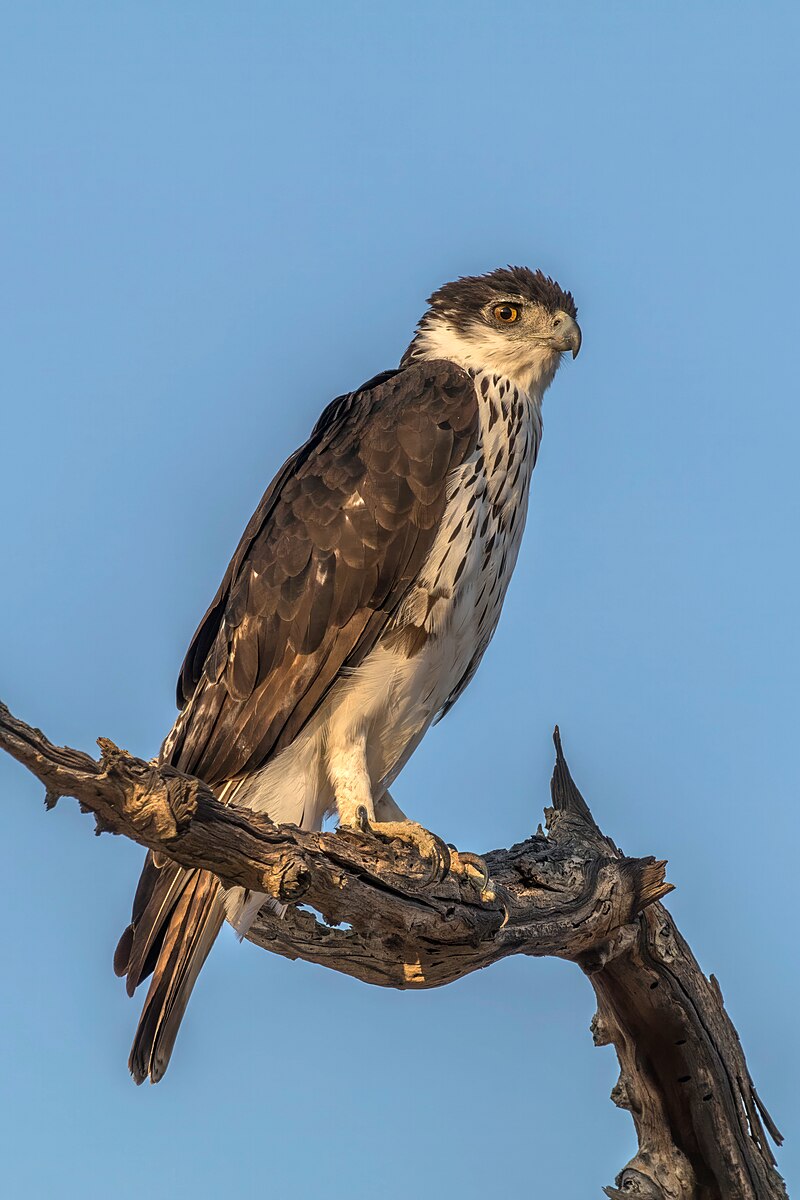The African hawk-eagle (Aquila spilogaster) is a large bird of prey found across much of sub-Saharan Africa, known for its distinctive call and boldly-patterned, dark-and-white plumage. This comprehensive guide will delve into the key differences between the African hawk eagle and its counterpart.
Identifying the African Hawk Eagle
The African hawk-eagle is a medium-sized eagle, measuring about 55-65 centimeters (22-26 inches) in length. Its upper parts are blackish, while the underparts are white heavily streaked with black. The underwing flight feathers are white with a black trailing edge, and the underwing coverts are mostly black with white spots. Sexes are similar, but young birds are brown above and rufous coloration replaces the black underparts of the adult.
Habitat and Distribution
 Image source: African hawk-eagle by Charles J. Sharp
Image source: African hawk-eagle by Charles J. Sharp
The African hawk-eagle is found in large parts of Africa south of the Sahara, including Angola, Benin, Botswana, Burkina Faso, Burundi, Cameroon, Central African Republic, Chad, DRCongo, Eritrea, Ethiopia, Gambia, Ghana, Guinea, Guinea-Bissau, Ivory Coast, Kenya, Malawi, Mali, Mauritania, Mozambique, Namibia, Niger, Nigeria, Rwanda, Senegal, Sierra Leone, Somalia, South Africa, South Sudan, Sudan, Swaziland, Tanzania, Togo, Uganda, Zambia, and Zimbabwe. It prefers to make its home in dry, woodland habitats, as well as in open savannas dotted with trees, and riparian forests.
Hunting Behavior and Prey
The African hawk-eagle is a carnivorous bird that primarily uses its sharp talons to catch its prey. It tends to hunt either from a perch or from the air and can see prey up to 1 km away. Its prey of choice tends to be birds, and it often flushes gamebirds such as spurfowl and guineafowl out of dense vegetation. It has been found that a pair of eagles can hunt cooperatively with one bird flushing and the other waiting nearby to strike. Other prey items include small mammals and occasionally reptiles and insects.
Breeding and Nesting Behavior
The African hawk-eagle is a monogamous species that typically places its nest (in the form of a large platform) below the canopy of tall trees, and the nest is built by both the male and female. Nests have been known to have been used for up to 60 years in some cases. Their courtship routine involves the pair soaring and calling above the nest. In many cases, the male will dive towards the female and the female, in turn, turns to the male and displays her claws. This mating ritual culminates in the male presenting the female with nuptial gifts in the form of prey. Eggs are laid in clutches of 1 to 2 between April and August. Incubation lasts around 43 days with both parents being involved.
Conservation Concerns
Despite being widespread throughout its range, the African hawk-eagle is facing serious threats, including habitat loss due to the cutting down of woodland trees and persecution by farmers who view them as a threat to domestic chickens and other fowl. Over the past few decades, they have become scarce to rare outside of protected areas across Africa.
Conclusion
In summary, the African hawk-eagle is a distinctive and adaptable bird of prey found across sub-Saharan Africa. Its unique physical characteristics, hunting behaviors, and breeding habits make it a fascinating subject of study for birdwatchers and conservationists alike. However, the species faces significant challenges due to habitat loss and human-wildlife conflict, underscoring the importance of continued efforts to protect this remarkable raptor.
References:
- African hawk-eagle – Wikipedia. (n.d.). Retrieved from https://en.wikipedia.org/wiki/African_hawk-eagle
- African Hawk-eagle | The Peregrine Fund. (n.d.). Retrieved from https://peregrinefund.org/explore-raptors-species/eagles/african-hawk-eagle/
- African Hawk-Eagle Aquila spilogaster – eBird. (n.d.). Retrieved from https://ebird.org/species/afrhae1
- African Hawk-eagle – Aquila spilogaster – Carnivora. (n.d.). Retrieved from https://carnivora.net/african-hawk-eagle-aquila-spilogaster-t7795.html
- African Hawk-Eagle: The Ultimate Guide – Operation Migration. (n.d.). Retrieved from https://operationmigration.org/african-hawk-eagle-the-ultimate-guide/

